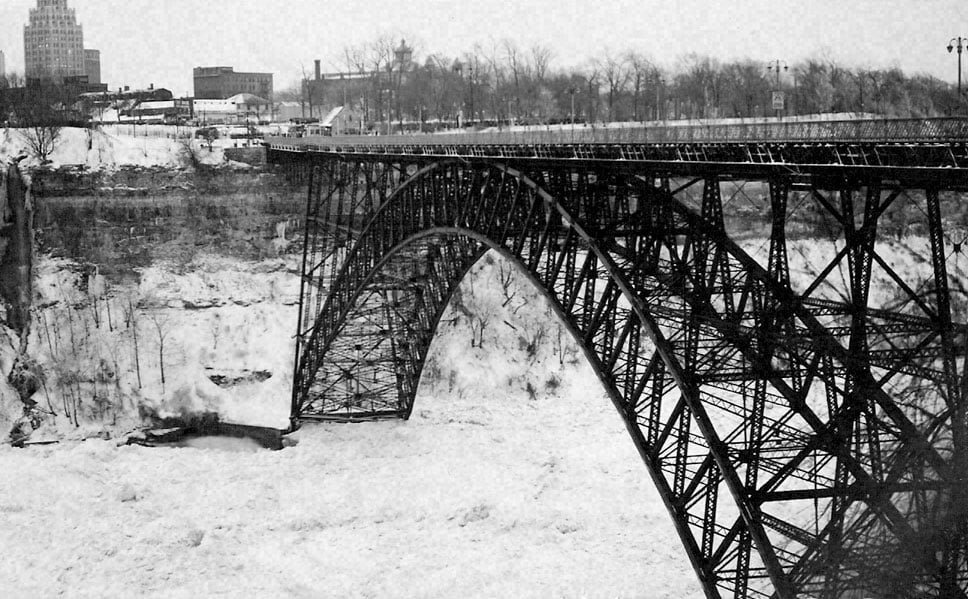Niagara Falls, renowned for its breathtaking cascades and vibrant attractions, harbors a history as dynamic as its rushing waters. Among its stories is the haunting tale of the Honeymoon Bridge, a marvel of its time that met an untimely demise on January 23, 1938. Known officially as the Falls View Bridge, this steel arch structure connected Niagara Falls, Ontario, to Niagara Falls, New York. Yet, it was no match for the harsh winter forces that transformed the landscape into a theater of destruction.
During one of the coldest winters on record, a powerful windstorm pushed massive ice formations from Lake Erie into the Niagara River, forcing ice over the iconic falls. These frozen giants accumulated relentlessly, forming an imposing ice bridge beneath the Honeymoon Bridge. The pressure was immense, and with each passing moment, the structure groaned under the weight of nature’s onslaught. Finally, the bridge collapsed, leaving behind a scene of devastation and a stark reminder of nature’s unyielding power.
Early Days
Constructed in 1898 by the Pencoyd Bridge Company of Philadelphia and designed by Engineer R.S. Buck, the Honeymoon Bridge was a remarkable structure. With an 840-foot span, it featured a two-hinged arch, a latticed rib, and trusses connecting the main span to each shoreline. Positioned close to the river’s edge, the abutments extended to the base of the gorge. However, this proximity to the water level would ultimately lead to the undoing of the bridge.
On June 23rd, 1897, the Upper Steel Arch Bridge was completed and opened for traffic, boasting the title of the world’s longest structure of its kind with an 840-foot span. This magnificent bridge featured a single floor, accommodating double tracks for electric trolleys, as well as space for carriages and pedestrians. Not only was it a functional crossing, but the Upper Steel Arch Bridge also stood as a lovely and graceful structure, offering a breathtaking view of the Falls.
Early Issues
The bridge’s abutments faced an ongoing challenge from ice bridges forming in the Lower Niagara River every winter, given their nearness to the river’s surface. A significant ice bridge posed a threat to displace the bridge from its foundations in early January 1899. Dedicated workers labored for three weeks, clearing ice around the abutments and steel girders, effectively minimizing damage to the structure.
Collapse Event
In the pivotal week of 1938, the Niagara River surged, reaching a height of 9 feet, submerging the Maid of the Mist docks and the surrounding area. Ice tightly wrapped around the abutments of the Honeymoon Bridge, prompting the suspension of all vehicle traffic on the day preceding the collapse. Fortunately, no casualties resulted from the traffic halt, except for the bridge itself.
On January 27th, 1938, at 4:20 pm, the Honeymoon Bridge succumbed to the force and plunged into the Niagara Gorge.
The lesson from the Niagara Falls Bridge Collapse led to the construction of the current Rainbow Bridge, strategically positioned about 500 feet north of the former Honeymoon Bridge location. This new bridge was built to endure strong winds and harsh weather conditions more effectively!
The Rainbow Bridge
The old Honeymoon Bridge had issues with pedestrians and vehicles, and its wooden deck made it especially perilous when wet. In 1930, a tragic incident occurred when an American driver lost control, skidded off the bridge, and fell into the gorge.
Click here to explore the fascinating Niagara Falls Ice Bridge phenomenon.
Niagara Falls Honeymoon Bridge Collapse Video
The intense 24-hour battle between ice and steel reaches its peak just past 4 o’clock in the afternoon, as the Falls View International Bridge dramatically collapses into the ice-packed gorge of the Niagara River. Thousands of onlookers witnessed the majestic steel structure’s fall from both sides of the gorge.
Today, visitors to Niagara Falls can explore the region’s captivating history while enjoying modern attractions like Clifton Hill, just a short stroll from the site of the former bridge. Known as Niagara’s “Street of Fun,” Clifton Hill boasts entertainment options ranging from arcades and wax museums to thrilling rides and vibrant eateries, creating a lively contrast to the somber echoes of the past.
This blend of historical intrigue and contemporary excitement makes Niagara Falls a compelling destination for travelers seeking both education and entertainment.
